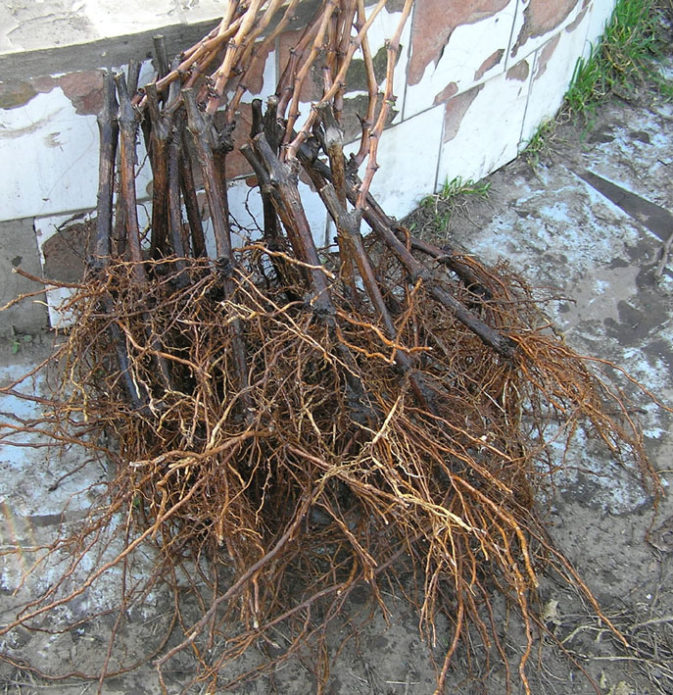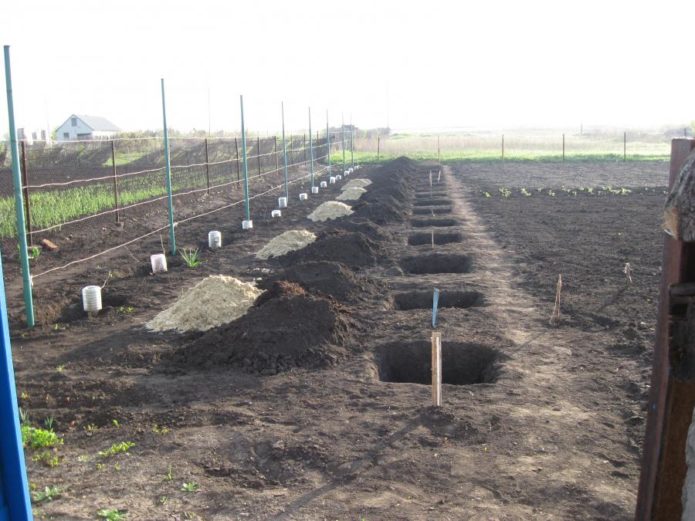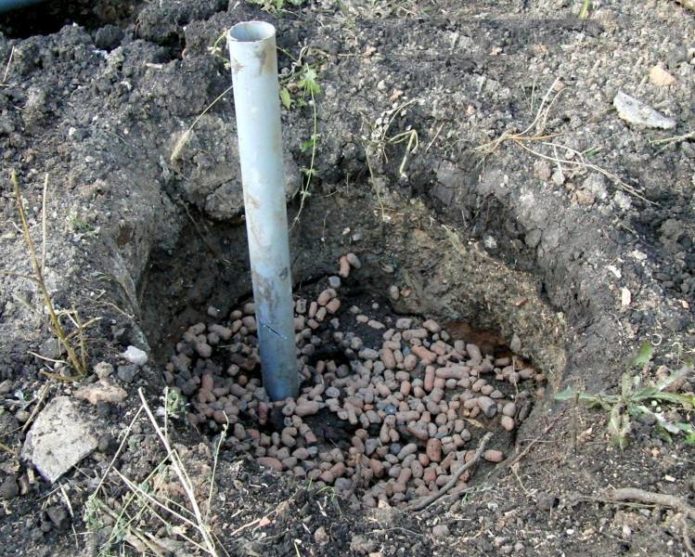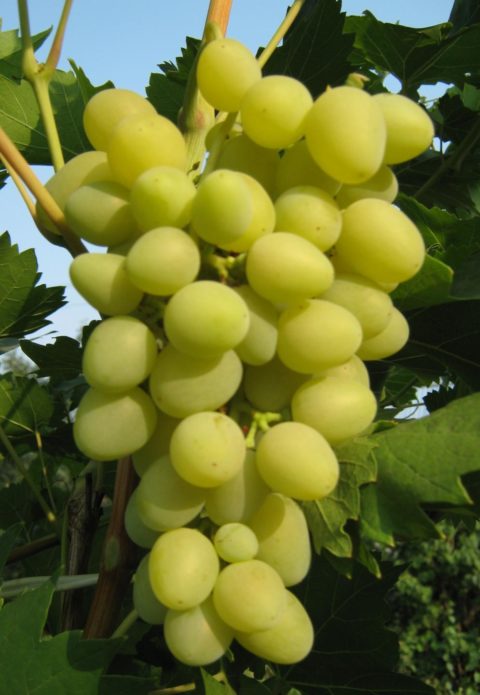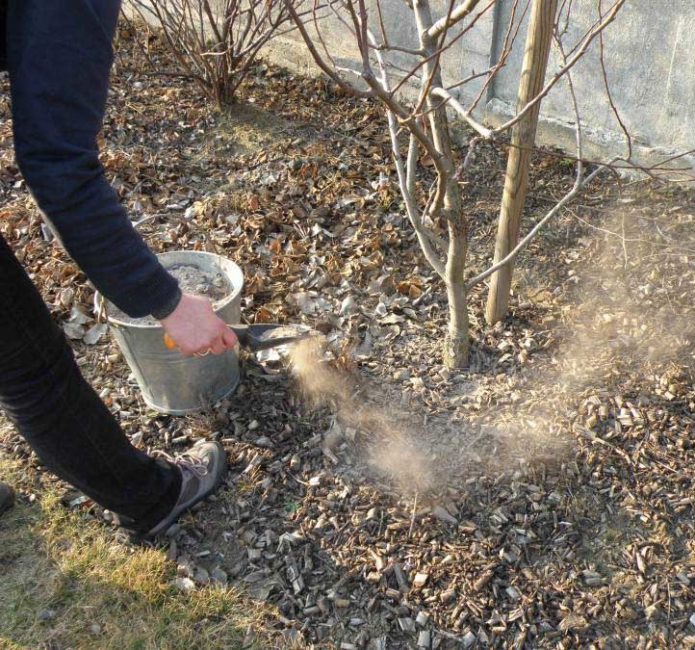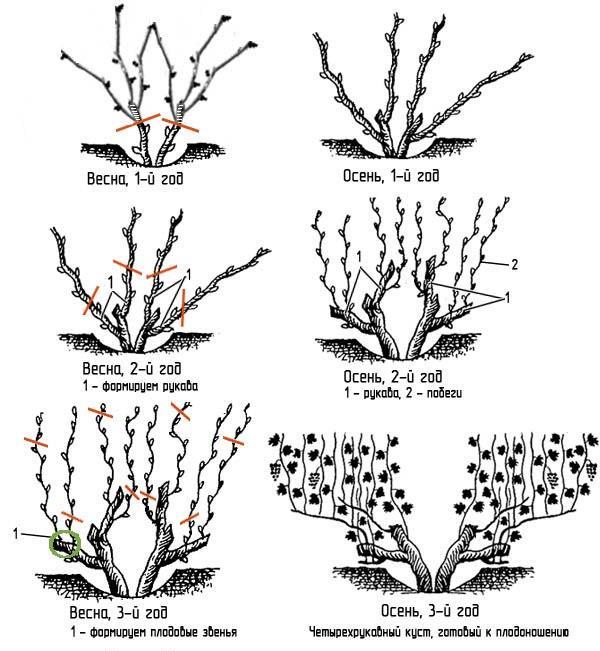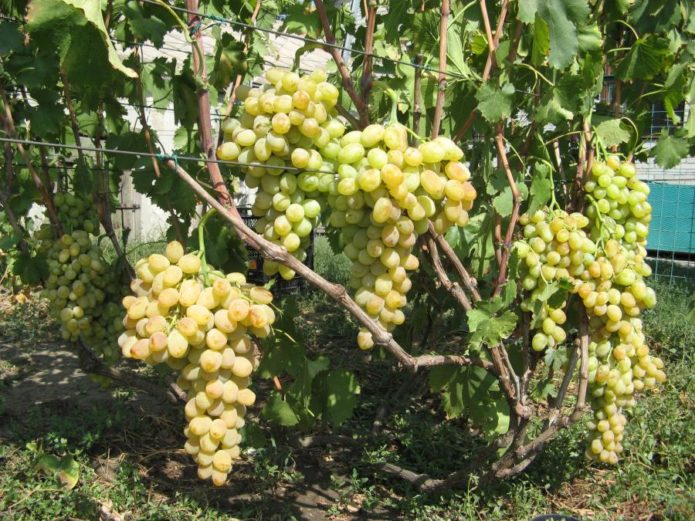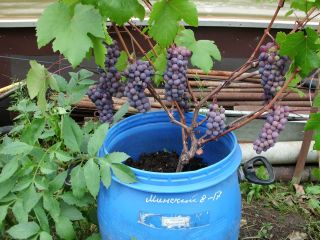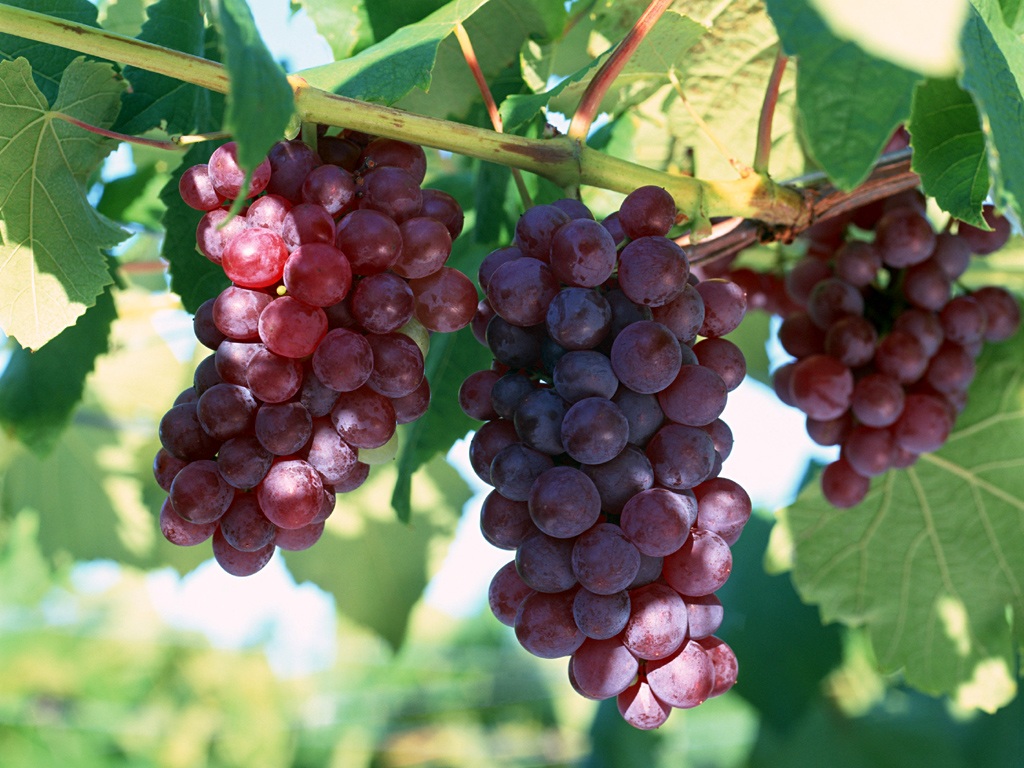Long gone are the days when grapes were considered an exotic southern berry. Thanks to the efforts of breeders and enthusiastic gardeners, he won his place in the summer cottages of central Russia. Perhaps the most inconvenient in growing it is only a shelter for the winter, otherwise growing grapes does not present any particular problems.
Content
Growing grapes in the country
For the successful cultivation of grapes in summer cottages, several factors must be taken into account that determine the success of this endeavor. Grapes are a light-loving plant. With a lack of sunlight, good berries cannot be obtained. The second important physical factor is heat: normal growth and formation of fruit buds occur at temperatures not lower than 20 ° С, the leaves of most varieties freeze at –1 ° С, and even perennial wood dies in frosts of –23–28 ° С. Grapes are a drought-resistant plant, but with a sufficient amount of moisture, the yield increases several times.
Preparing grape seedlings for planting
The best time for planting grapes in most regions is the end of April. In the south, subject to shelter for the winter, autumn planting is also possible - almost all of October.
Experienced growers grow planting material themselves, purchasing grape cuttings of their favorite variety from reliable sellers or from friends. But novice summer residents most often buy grape seedlings, which are not always possible to plant immediately, since growing grapes requires careful preparation of the site for planting and arranging a planting pit.
When transporting the purchased seedlings to the dacha, the purchased seedlings must be placed in a damp cloth: before planting, the seedlings must not dry out. If they have to languish in anticipation of a place of residence for several days, you can simply dig them into the damp ground. If this is not possible, so, in a wet rag, they will quite last a week and a half.
Spring work with grapes - the first processing and garter, top dressing and frost protection:https://flowers.bigbadmole.com/en/yagody/vinograd/vesennie-rabotyi-s-vinogradom-posle-zimyi.html
On the seedling, remove all the upper roots, if any, leaving the roots only on the heel itself. It must be trimmed and broken. To restore normal moisture, the seedlings are soaked in water for one to two days. Even better, if instead of water, take a weak solution of urea: 1 tablespoon in a bucket of water. It is necessary to keep both the roots and the vine in this solution.Before planting, the roots are dipped in a mash of the consistency of liquid sour cream containing two parts of clay, one part of fresh cow dung and water.
Choosing a place for grapes in the country
The grapes grow both on level ground and on the temperate southern and southwestern slopes. It should not be placed in the lowlands and on the northern slopes due to the danger of damage by late spring frosts. Grapes are unpretentious to the type of soil: it grows everywhere, except for very wetlands and areas with groundwater occurrence closer than 1.5 m from the surface. For planting grapes in the country, you need to choose sunny areas protected from the wind.
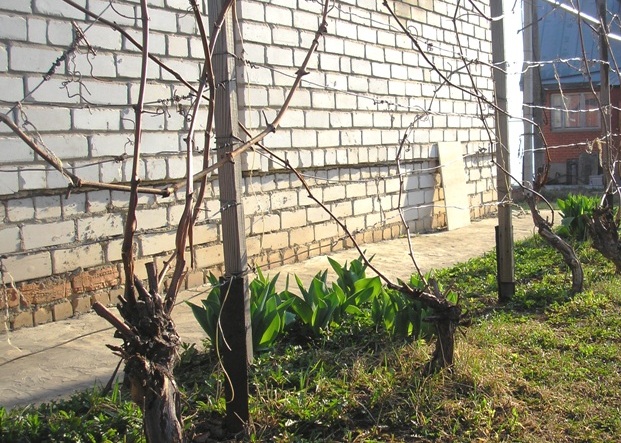
The wall of the house protects the vineyard well from the wind. The main thing is not to cover the sun
Almost all fruit trees are considered good predecessors, but grapes should not be planted in the place where they used to grow: sores accumulate, and useful soil components are wasted. Most often, grapes are planted in the place where vegetables were previously grown. The best way out is to sow green manures - oats, lupines, mustard - in the last year before planting grapes.
Most common garden crops can be planted next to grapes, but the best neighbors for it are peas, onions, beets, strawberries, carrots, cucumbers, and sorrel. Does not like grapes with tomatoes, corn, horseradish. Surprisingly, grapes do not tolerate being close to calendula, even at a distance of several meters.
Soil preparation and planting pit for grapes, fertilization
First, for planting grapes, you must carefully prepare the soil. This should be done for spring planting in autumn, and for autumn planting in spring. Pre-planting soil preparation at the summer cottage consists in digging it onto a shovel bayonet with the introduction of fertilizers. Sometimes the question arises: why? After all, for planting grapes, we will still prepare a pit with a nutrient mixture. The fact is that we are not planting a bush for 3-4 years: he will have to live in this place for a long time, and the grapes will spread the roots not only in depth, but in all directions. It is better to provide them with sufficient nutrition in advance for several years in advance, so as not to dig unnecessary holes for fertilizing, not to injure the roots during such digging. By the way, unlike vegetable beds, when digging, there is no point in throwing fragments of bricks, not very large stones and other debris from the ground: grapes love stony soils.

Grapes are so fond of stony soils that a large amount of gravel, including for drainage, is even placed in planting pits.
In the first years of life, grapes require more phosphorus nutrition, which stimulates root growth. Nitrogen fertilizers are needed from the second and third year after planting. But since it is difficult to apply fertilizers close to the roots without damaging them, in advance, before planting, they enrich the soil with manure (humus), phosphorus and potassium. And fertilization in the planting pit is another story. You can dig it when there is time and the condition of the soil allows.
They plant grapes in the pits. Most often this is done near various buildings. It is especially good if the wall of the house blocks the planting from cold northerly winds. They dig a large pit for planting grapes: at least 80 × 80 × 80 cm in size. At the same time, the depth on certain types of soil can be even greater, only it is not easy to dig such a hole in a summer cottage, and few people do it. Moreover, some amateurs plant grapes “under scrap”: in the wet ground they punch a hole with a metal crowbar (as it happens), widen it a little by staggering and plant grapes. The bush is said to like it. We will not argue or argue that this is not the case, but we will not recommend such a fit. A pit with nutritious soil for a long life and fruiting grapes need!
All about planting grape seedlings! Site preparation, planting depth and scheme, fertilization and watering:https://flowers.bigbadmole.com/en/yagody/vinograd/kak-posadit-vinograd-vesnoy-sazhentsami.html
A well-mixed mixture of humus, good earth, sand and mineral fertilizers must be laid at the bottom of an 80-centimeter hole with a layer of 20 cm. The fertilizer can be a complex fertilizer - for example, azofoska, 500 grams, and the rest of the mixture components in approximately equal volumes. The second layer, 10 cm thick, will be a drainage layer: crushed stone, broken brick, various solid non-decomposing waste (broken glass, slate fragments, etc.). Through such a rocky barrier, grapes will send their active roots in search of food. It's a good idea to bury a few old canned food cans in this layer - there will be iron feeding. Anything above the drainage, that is, 50 cm thick, will be soil mixed with humus (3: 1). On very acidic soils, up to 0.5 kg of lime can be added to this mixture. You cannot fertilize the soil abundantly - young roots will burn. But we will fill in the mixture later, when planting a grape seedling. Yes, that's right: we will bury the seedling "up to the neck." The grapes are planted deeply so that the main roots extending from the heel of the seedling do not know the temperature of the soil below -5 ° C. In the meantime, you can pour a couple of buckets of water into an empty hole, on gravel.
If we plant several bushes at once, we must decide with the distance between the holes. For low-growing varieties, the minimum distance between bushes in a row should be 1.25 m, for medium-growing varieties - 1.5 m, vigorous ones - 2 m, and even more if possible.
Planting and transplanting grapes in the country
So, in our pit so far there is only a fertile layer, covered with gravel. Let's try a sapling by placing it on gravel. If its height is such that several buds stick out of the hole, that's good. If it is too short, we will pour a mixture of soil with humus so that the shoot, placed with the heel on this mixture, looks out. Before planting, we need to drive in a strong stake, to which at first we will tie up an intensively growing vine, as well as a piece of a strong inch pipe through which we will water the roots for the first 1-2 years. If you live in a not very arid region, and the soil is light, permeable, you can do without a pipe. Now we fill in a small mound of earth and plant a grape bush.
We set the seedling on a mound, spread the roots evenly, fill the hole in half, trample down and pour out two buckets of water. Then we fill the hole with dry soil to the top. We put more earth on the top of the seedling, making a hill 2–3 cm high above the upper bud.
If for some reason it was required to transplant a grape bush, it is not easy to do this, and success is guaranteed only in the case of young bushes, up to 5 years of age. This can be done both in spring and autumn, but when he has already dropped the leaves. The older the bush, the larger the clod of earth should remain on the roots when transplanting. An irrigation pipe driven into the pit is required in case of transplantation: the roots will need a lot of water to take root. The transplanted bush must be heavily pruned, and water abundantly two days before digging. A trench is dug around the bush so large that two people can fit in it with their feet. The roots protruding beyond the lump are cut off. The side walls of the coma are wrapped in burlap, something strong is placed under the bottom of the coma and the clod is taken out. They water the bush very well in a new place, and if it is autumn, then they cover it especially carefully for the winter.
Taking care of grapes in the country
Having planted grapes in the country, you must be prepared for the fact that you will have to take care of it constantly. No, you don't need to be very scared, of course, most of the works are quite accessible to a beginner, but you will need to learn something. Few summer residents can visit the site all year round, but, in an amicable way, work in the vineyard is required in winter. So, if you managed to visit the dacha in December or January, you can throw snow on the bushes.In February it is necessary to check whether everything is available for intensive work in spring and summer. And in March, it is already possible to finally decide on a plan for future work, including planning a site for new plantings. But intensive work with grapes begins with the arrival of the first warm days.
In early April, the bushes wrapped for the winter should be opened. If possible, you can apply fertilizer to the grooves, dry or as a liquid top dressing. In the middle of the month, the branches, while tied, can already be lifted from the ground and tied to the wires for ventilation. At above-zero temperatures, you can spray the vineyard against diseases (nitrafen or Bordeaux liquid). At the end of the month, the vines are already tied up according to all the rules. And new landings can already be done!
May works vary by region. Somewhere in this month, the grapes are just waking up, and somewhere greens are already rioting with might and main: buds bloom, leaves and flowers appear. At this time, it is very convenient to make a fragment of extra shoots: it is much easier than cutting off already strong unnecessary branches later. At the end of the month, you need to repeat the liquid top dressing and finish planting new bushes.
In June, you can plant young bushes grown from the winter from shanks at home. Foliar dressing can be done before the flowers bloom. As they grow, they tie up young shoots, remove extra stepsons and extra bunches so as not to overload the bushes.
In July, you need to feed the bushes while the berries are growing. Foliar feeding with Novofert is very convenient at this time. They continue tying up intensively growing vines to wires and removing stepsons. Actually, operations with green units continue next month.
In August, adults and young bushes are fed with mineral fertilizers, but without nitrogen. If necessary, moderate watering is also carried out. From the middle of the month, watering is stopped. The early grape varieties are being harvested.
September is the main berry harvest month. If the harvest is too large, there is little good in this either: the bush will spend energy on ripening the crop, and only then on ripening the vine. Therefore, in the event of an overload of the crop, foliar dressing with phosphorus-potassium fertilizers is imperative. If signs of disease are found, bushes with berries are sprayed with colloidal sulfur or potassium permanganate.
New bushes are planted in October. After planting, they must be covered with non-woven material or needles. After frost and foliage fall, serious pruning can be done. If necessary, cuttings are prepared at this time for the February planting at home. After pruning, at the end of October, the vines are removed from the trellises and covered for the winter. In very dry weather, good watering is carried out (several buckets of water per bush). All the remains are burned, they dig up the soil around the bushes.
November is the month of cleaning up unfinished business in October.
Fertilizers in the vineyard are applied throughout its life: starting from planting. Top dressing is done as needed, but annually. Grapes are very fond of potassium, so potash fertilizers can be used in the maximum possible dose, and ashes - almost as much as there is. The main application is in autumn or early spring fertilization in deep holes dug next to the bushes (do not chop the roots!). In autumn, organic fertilizers are used, to which you can add superphosphate and ash. In the spring, use any fertilizer, including nitrogen. Then the root dressing is repeated two to three weeks before flowering. Under each bush, you can fill up 2-3 liters of ash, close them up to a depth of 10-15 cm and water well.
It is often more convenient to carry out foliar dressing by spraying the foliage with weak fertilizer solutions.In order not to burn the sheet apparatus, this procedure is carried out in the evening hours. The first foliar dressing is a week before the flowers bloom. For her, take solutions of complex fertilizers (for example, azofoski). The following dressings are performed after flowering, two weeks after the previous one with the same compositions, as well as with the beginning of ripening of berries. Solutions must be prepared strictly according to the instructions for the preparation.
Often foliar dressing is combined with treatment with Bordeaux liquid to fight disease. The simplest option, combining top dressing with prevention, is the use of wood ash, which is infused in water for a day (a handful of ash in a bucket of water). After that, the infusion is filtered so as not to clog the sprayer nozzle. If the diseases attacked the grapes thoroughly, it is necessary to urgently study the special literature and stock up on powerful "chemistry", but it is better not to bring it to this, but to extinguish the foci in time with proper care of the bushes: feeding, watering, pruning.
Watering the grapes
The need for vineyard watering is highly dependent on the region and the current weather. The only thing that is clear is that watering of young bushes is required while they have a weak root system. In the year of planting, young bushes are watered several times, 4–5 buckets per bush, mulching after irrigation with humus or peat.
To answer the question about the need for watering, you can take the soil from a half-meter depth, squeeze it into a lump and throw it from a height of 1 m. If the lump has disintegrated, you need to water it. Most often, watering is required immediately after flowering and, in dry autumn, before the onset of frost. The norm in the summer is 2-3 buckets per bush, and more before winter. Excess moisture can cause uncontrolled growth of shoots, their poor ripening, and berries will ripen worse. Watering is very convenient to combine with the introduction of root dressings.
Perhaps the most important watering is water-charging, especially in the case of a dry autumn. Without such watering, the soil freezes deeply, the earth breaks off the roots from this. Frosty air gets into the soil cracks, which can even destroy the grape bush. Such watering is carried out after the leaves fall.
How about summer? Even if the weather is dry, you cannot water the grapes before or during flowering: the flowers will begin to crumble and the berries will be tied up much less. Watering is required when the berries are being poured, but no later than 3-4 weeks before harvest. But in general, the vineyard does not need extra moisture: its roots penetrate deeply, and, unless the season is extremely dry, they will find water themselves.
Pruning grapes
Pruning is perhaps the most difficult of all things in the vineyard: you cannot immediately learn to prune a vine correctly, there are secrets here, and they cannot be revealed within the framework of a review article. Therefore, the gardener must definitely study the special literature on this issue. It is important to understand that pruning is essentially a surgical operation that requires knowledge and creativity. Everything depends on the correct pruning of grapes: from the growth of bushes to the quality and quantity of the harvest. It is important to be able to grow strong shoots already in the first year after planting, and this will be the only autumn when they do not need to be cut. Until the beginning of fruiting, which will begin in just a couple of years, the bushes are cut in the spring. After four years of life - only in the fall.
The only simple rule, which is understandable to a beginner, is the need to cut out dead sections of the bush and shoots that thicken the bush, which interfere with the growth of stronger ones. The second universal rule is that if only one shoot has grown on a young bush, during the first spring pruning, only two buds are left on it, from which two strong branches will grow by autumn. And then ... Then there are so many options for forming a bush that you need to arm yourself with a book, patience and a good pruner. And you will find out what a fan or multi-fan formations are, most often used in not too warm regions. And you will be able to form bushes from 4-8 arms, coming from the very base.
Well, to make it easier for yourself to work on autumn grape pruning, it is necessary to break out young green shoots throughout the summer if they did not grow where you would like. The bush will react less painfully to breaking greenery than cutting out an already ripe vine. With timely breaking, no tools are required: the green shoot is removed with bare hands. The first time you need to walk through the bush after budding, when the shoots grow up to 5–6 cm. The second - when it will be easy to distinguish an shoot with future bunches from a useless one. You should not engage in breaking out shoots only during flowering.
With the correct pruning, by the age of 3-4 years a bush is created that is capable of stable, abundant fruiting: it is as illuminated as possible, it is well ventilated, and it is easy to care for it.
Preparing grapes for winter in the country
In most regions of our country, except for the primordial wine-growing regions, grapes have to be sheltered from frost for the winter. Most cultivars, at least. Isabella grape and Amurskiy will survive rather severe frosts. Before sheltering the bushes for the winter, a thorough pruning is carried out, first of all removing the unripe parts of the vine. After the first frost it is very easy to recognize them: they break at the slightest touch. Well-ripened vines are removed from the supports and laid on the ground, tied in bunches convenient for shelter. Whitewashing of the vine, especially the lower parts, gives a good disinfecting effect at this time.
Further options are possible. The grapes are sheltered at the end of October, but the method of shelter depends on how severe the winters are in the region, how stable the snow covers and what kind of grapes we are talking about. Most of the modern varieties bred in recent years can withstand frosts down to -25 aboutC. Nevertheless, many summer residents still dig trenches just in case, lay vines in them and cover them with a large layer of earth.
In most cases, this cannot be considered justified: an extra waste of energy and the risk of damping out if you do not know how to come in the spring and dig it up in time. Those summer residents who wrap bundles of vines in plastic bags also pose a huge risk of vines damping out. Perhaps the most reliable should be recognized as a reliable shelter of vines removed from trellises with spruce or pine spruce branches, and a large number of dry leaves from the fall of fruit trees. Covering with old rags is not the best approach: they will keep warm not only the grapes, but also the mice, which will eventually nibble all the bark and leave you without grapes. Well, if there is no spruce branches, the bunches of vines laid on the ground can be covered with boards, slate, plywood, etc.: until there is snow, the bushes will be blown by the wind, and the mice will not start. And under the snow the grapes will be warm, as long as it falls on time and in sufficient quantities.
Winter "fur coat" for the vine, how to prepare the right shelter for the winter:https://flowers.bigbadmole.com/en/yagody/vinograd/kak-ukryvat-vinograd-na-zimu.html
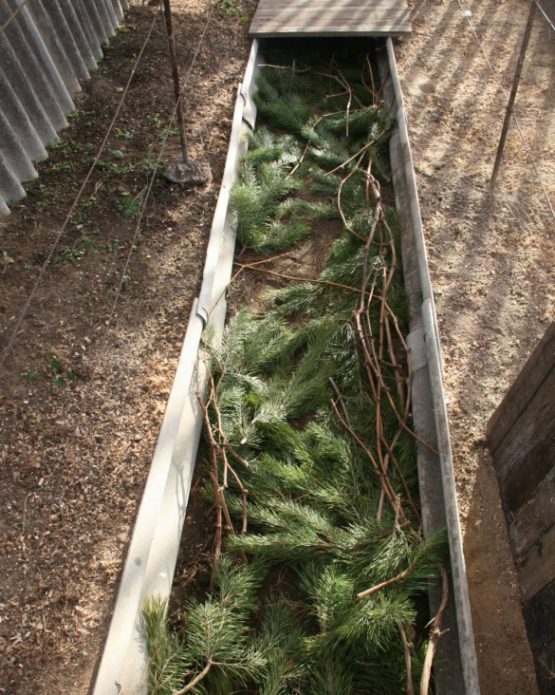
One of the ideal options for sheltering grapes for the winter involves both the construction of a box and the use of spruce branches
Propagation of grapes
The most common breeding method is cuttings. During autumn pruning before sheltering for the winter, well-ripened cuttings should be cut from strong annual shoots - pieces of shoots at least 30 cm long, the thicker the better (from cuttings with a thickness of less than 5 mm, seedlings develop weaker). Each should have at least 5 buds developed: cut off the excess in the spring. Until February, cuttings should be stored in a cellar or refrigerator in plastic bags (not completely sealed closed). The optimum temperature is around 0 ° C. (In the southern regions, it is possible to plant cuttings directly in open ground in October or April-May).
Their integrity is checked in mid-February. If you cut the bark, you can see green wood on a living cuttings: you can plant.For home planting, cuttings with 2-3 buds are cut. The upper cut is made 2–3 cm above the kidney, the lower 1–2 cm under the kidney. The bottom cut should be oblique. The upper (straight) after planting will need to be covered with garden varnish or plasticine, but first the cuttings are soaked in water for a couple of days.
Before planting, at the very bottom of the cutting, several longitudinal scratches must be made to facilitate rooting. The most convenient container for planting is a 1.5 liter plastic bottle with a cut off top and holes made in the bottom to drain excess water. The best substrate is scalded sawdust of coniferous trees, but any light soil is also suitable. The stalk is planted in a bottle so that one bud remains on the surface. Immediately poured with a weak solution of potassium permanganate and cover with a plastic bag until the leaves appear.
The planted cuttings are kept warm (25-28 ° C). When the leaves appear, lights are added and the stalk is gradually taught to be without a bag. When a "bouquet" of leaves is formed, you should carefully try to pull the plant out of the substrate. If it doesn't work, then the roots have already formed. During home growing, the future seedling is watered abundantly with settled water. It is advisable to feed it twice with complex fertilizer. The rest of the concern is reduced to compliance with temperature and light conditions. A rooted stalk by May - June will already be a ready-made seedling.
The grapes are propagated by seeds. It is possible to obtain seedlings and layering, just like currants. To do this, they use laying in trenches of both matured vines (in autumn or early spring) and long young shoots (in summer). In the second or third year, the layers are separated from the mother bush. In order to obtain bushes of the desired varieties, the implementation of vaccinations is also practiced. Vaccinations are usually performed in an improved copulation method. The optimal dates are from late March to mid-April.
Video: growing seedlings from shanks
Methods for growing grapes in the country
Vine by nature, grapes require a support to ensure normal fruiting. In the wild, these are tree trunks, but in the country, supports must be created. The presence of supports helps to form a bush according to the chosen scheme and provides convenience in caring for it.
Growing on a long vine
When they say "growing grapes on a long vine", they do not mean by this the long-term cultivation of the crop itself, but the method of planting. The fact is that planting habitual cuttings in some areas with the hands of inexperienced gardeners does not lead to mandatory success, and in this case there is another method of planting. It needs a really long vine: a piece of an annual shoot up to one and a half meters long, or even more. This piece is cut off in the fall, soaked in water for 24 hours and immediately buried in the planting hole. Indeed, they bury it, rolling it up in a hole in a ring and releasing only 1-2 kidneys outside. They fill the hole with soil, water it and leave it for the winter, covering it with spruce branches for reliability.
Usually, with this method of planting, stronger roots are formed, but in this option, an irrigation pipe, dug into a hole in advance, is necessary: water will be required for the lower parts of the vine, from the buds of which the roots will form. The future bush is formed as usual: according to the method chosen by the gardener.
Growing in a greenhouse
Most varieties mature two to three weeks earlier in the greenhouse. Even an unheated greenhouse protects the grapes from hail, acid rain, damage from light frosts. Grapes are planted in a greenhouse so that a little more than a meter remains between the bushes, and half a meter from the walls of the greenhouse. The advantage of growing grapes in a greenhouse is the ability to regulate the amount of incoming moisture, but you have to water it yourself. In the greenhouse, grapes are watered at least three times over the summer, while fertilizing them. Watering is stopped in August, but watering in the winter is also required.
In summer, it is necessary to ventilate the greenhouse so that condensation does not accumulate, and the air humidity is not close to 100%. Shelter for the winter in a greenhouse is still required. What is the point of using greenhouses? After all, grapes are not tomatoes, they are a very large liana, and you will have to tinker with them a lot. Of the advantages - a guaranteed harvest and an extension of the growing season, ease of use in bad weather. However, there are many disadvantages. The main thing, of course, is the cost. But there is also an increased risk of fungal diseases due to poor ventilation of the bushes and, perhaps most importantly, a smaller amount of natural sunlight reaching the berries, and hence all that for which we do not really like greenhouse products.
Growing on trellis and other supports
The most common way of growing grapes in the country is on any suitable supports, most often on the so-called trellises. Supports can look different: from crossed vertical and horizontal pipes to metal or plastic mesh with large (20-30 cm) meshes. The even distribution of the arms and vines ensures optimal lighting and ventilation of the bush.
For the installation of trellises, it is necessary to drive the required number of strong posts or metal pipes into the ground. Their height above the ground should be from 2 to 3 meters (depending on the grape variety and the owner's preferences). The quantity is such that they firmly hold the thick wire stretched between them and the load of bushes with the harvest that will fall on this wire. Usually 4-5 horizontal rows of wire are pulled. The lower tier is placed at a distance of 50 cm from the ground, the subsequent ones - every 30-50 cm.
In the spring, after opening the grapes, the overwintered vines are tied horizontally to the bottom wire. Young shoots that appear in the summer are tied up in an upright position, while breaking out the excess ones. Leave no more than 30 shoots per adult bush. Both the number of shoots and the weight of the crop are normalized in time, removing extra brushes.
Growing in barrels
In the southern regions, grapes are grown even in barrels, placing them on balconies. You can do this with growing grapes in the middle lane, but already on the glassed-in loggia. But there is no point in planting in barrels at the dacha, except in cases of areas that are not at all adapted to viticulture. In such cases, for the winter, the barrels together with the bushes are buried in the open ground in the country, and in early spring the barrels are transferred to the greenhouse. In the greenhouse, the grapes are allowed to bloom and set fruit, and after the frost stops, they take it out into the fresh air and put it in the sunniest place. In barrels, grapes can grow up to 8-10 years.
The barrel should have a volume of 200-250 liters. Several holes must be made in the bottom for water drainage. Drainage is placed on the bottom - a layer of fine gravel, then fertile soil. Varieties for planting in barrels should be medium-sized, early and disease-resistant. The vines are grown with no more than 10 buds, so the harvest, of course, cannot be compared to the usual one that is obtained in natural conditions.
Growing in containers
It is not always possible to place a 250-liter barrel on the farm, and then for growing grapes you can try to use slightly smaller containers. You can find both plastic containers of 50 liters, and take a regular plastic bag up to 50 cm in size in each dimension. By placing good soil with fertilizers in it, you can plant a grape cut and do the same as with a barrel. The trouble is that the plant will begin to lack such a volume of soil very soon. Perhaps the bush will have time to give the first small harvest. Maybe even two.But then it still has to be transplanted into the ground (open ground or greenhouse) by cutting the container. Thus, the term "container growing" refers not to a full-fledged bush of grapes, but to a seedling.
Features of growing climbing (maiden) grapes
Maiden grapes are an ornamental plant, used mainly to decorate a plot, including a summer cottage, because in a very short time it wraps around all the supports provided to it with openwork shoots and leaves: walls, gazebos, fences. In the spring and summer, the leaves of the maiden grape are dark green, in the fall they are purple-red. Climbing shoots of liana tendrils cling to any support, can grow up to 15–20 m. The berries are dark blue in color and are completely inedible.
Maiden grapes can grow anywhere, but are most decorative in sunny locations. He does not like cold winds, but he loves any solid supports, as a result of which it often becomes not only a decorating plant, but also an interfering one, so you must first think carefully about where to plant it so that you do not cut it off later, for example, from electrical wires. It can be grown both from seedlings and from seeds, it reproduces well by self-sowing. Can be planted both in spring and autumn. Care requires only in the first years: 3-4 watering per season and loosening around underdeveloped bushes. In subsequent years - only pruning of disturbing vines.
Propagated by cuttings, root suckers, and layering. It is completely frost-resistant and requires shelter for the winter, only in the very northern regions. Resistant to diseases and pests.
Growing grapes in the country is a fascinating and rewarding activity. This is a vine that can grow on its own, but in most regions it needs care. It consists, first of all, in timely pruning and shelter for the winter. Perhaps these are the most difficult stages in growing it, and the rest is not difficult at all.
